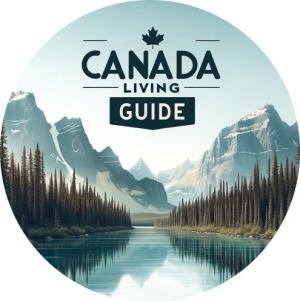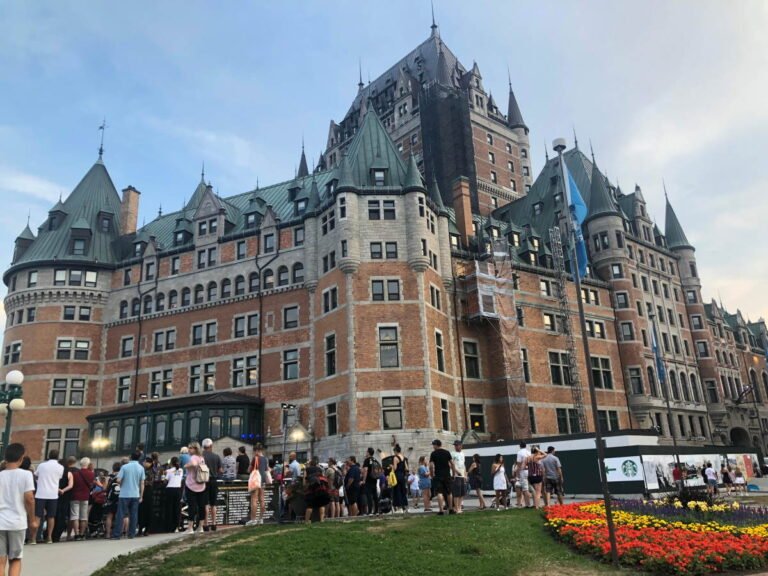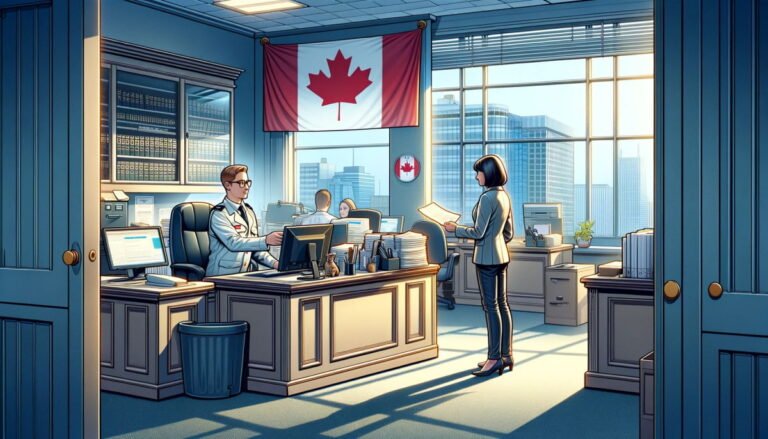Canada Tourist Visa Simplified: Start Your Canadian Dream Trip Today
Planning your visit to the breathtaking landscapes and vibrant cities of Canada?
Obtaining your Canada tourist visa is the crucial first step, opening doors to a host of advantages. This process is your gateway to experiencing the diverse attractions and warm hospitality that this beautiful country offers.
Whether you’re dreaming of capturing the scenic beauty of the Rockies and Niagara Falls, exploring the multicultural streets of Toronto, or soaking in the French-Canadian charm of Quebec, securing your tourist visa to Canada turns those dreams into reality.

A visitor visa, also known as a temporary resident visa, is a requirement for most travelers intending to visit Canada. This visa typically allows a stay of up to 6 months.
However, the duration of your stay is at the discretion of the border service officer upon arrival. They may permit a shorter stay and, if so, will stamp your passport with a departure date. In the absence of a stamp, you are allowed to stay for the full 6 months.
Eligibility for a Canada Tourist Visa
Eligibility for a Canada tourist visa hinges on several key criteria that applicants must meet to embark on their Canadian adventure.
Applicants need to meet the visitor visa requirements and the best is to follow the checklist for a tourist visa, which includes formalities and documents to collect including a valid passport, proof of sufficient funds for the stay, and no criminal or immigration-related convictions.
Note that eligibility criteria can vary based on the applicant’s nationality.
For instance, citizens from visa-exempt countries may only need an Electronic Travel Authorization (eTA) instead of a traditional visa.
On the other hand, nationals from other countries might need to provide more extensive documentation and undergo a more rigorous application process.
Therefore, it’s important to check the specific requirements for your nationality to ensure a smooth application process and hassle-free entry into Canada.
Canada Tourist Visa Checklist
Creating and using a checklist is a great way to ensure you have everything you need for your Canada tourist visa application. Here’s a comprehensive list to help you get started:
- Valid Passport: Ensure your passport is valid for at least 6 months beyond your planned date of departure from Canada.
- Completed Visa Application Forms
- Passport-Sized Photographs: Recent photographs that meet the Canadian visa photo requirements.
- onliProof of Financial Support: Bank statements, pay slips, or a letter from a sponsor.
- Travel Itinerary: Details of your flight bookings, hotel reservations, and a plan of your activities in Canada.
- Letter of Invitation (if applicable): From a friend or family member in Canada.
- Proof of Ties to Home Country: Employment letter, proof of real estate property, family ties, etc.
- Travel Insurance: Coverage for the duration of your stay in Canada.
- Visa Application Fee Receipt
- Biometrics Confirmation (if required): Receipt or appointment confirmation for biometrics submission.
- Medical Examination Results (if applicable): Required for certain countries or if you plan to stay longer than 6 months.
- For students or employees, letters from educational institutions or employers.
- For business visitors, relevant documents related to your business in Canada.
- Photocopies of All Original Documents: Keep copies of all documents and forms submitted.
- Self-Addressed Return Envelope: If you are required to send documents by post.
- Cover Letter (optional but recommended): Explaining the purpose of your visit and outlining your travel plan.
- Check for Specific Requirements: Based on your country, there might be additional requirements.
Types of Canadian Tourist Visas
When planning your trip to Canada, it’s important to know the different types of tourist visas available, as each caters to different travel needs and durations. Here’s a breakdown:
Single Entry Visa
The Single Entry Visa, as its name implies, permits a single entry into Canada. This type of visa is perfectly suited for those planning a one-time visit, whether for a special event, a holiday, or a brief weekend getaway.
It’s important to remember that once you depart Canada, re-entry will generally require a new visa application.
It’s worth noting that obtaining a Canadian tourist visa can be challenging, and approval is not guaranteed even with a family member vouching for the applicant.
For example, there are instances, such as in our personal experience, where a cousin’s application was denied multiple times despite our status as Canadian citizens in good standing. Such cases often end with a standard refusal notice, lacking detailed explanations, which can be a disheartening experience for both the applicant and their family.
Multiple Entry Visa
This visa is more flexible, allowing you to come and go from Canada for six months at a time, without having to reapply each time.
It’s valid for up to 10 years or one month before your passport expires, whichever is shorter. It is perfect for those who wish to visit Canada multiple times, perhaps to visit family or explore different parts of the country over a few years.
Transit Visa
Required for travelers passing through Canada for less than 48 hours on their way to another destination.
This is generally free and needed when you’re travelling to another country via Canada.
Super Visa
- Specifically for parents and grandparents of Canadian citizens or permanent residents.
- Allows longer visits – up to two years at a time without the need to renew your status.
- A more convenient option for family members who want to spend extended time with their loved ones in Canada. This is the type of visa we obtained for our parents when they frequently visited us to spend time together and help with our kids.
Electronic Travel Authorization (eTA)
Not a traditional visa, but a requirement for visa-exempt foreign nationals traveling to Canada by air.
It’s electronically linked to your passport and is valid for five years or until your passport expires.
Each type of Canadian tourist visa has specific requirements and it’s crucial to choose the one that best suits your travel plans. Whether you’re visiting for a short period or planning frequent trips to Canada over the years, understanding these options ensures a hassle-free and enjoyable travel experience.
Required Documents for the Visitors
When applying for a Canada tourist visa, preparing the right documents is key to a successful application (but not always). Here’s a detailed list of the required documents:
Valid Passport
Your passport should be valid for the duration of your planned stay in Canada. It must have at least one blank page other than the last page.
Completed Visa Application Forms
You’ll need to fill out the necessary application forms, which can vary based on the visa type. Ensure all forms are completed accurately to avoid delays.
Photographs
Recent passport-sized photographs that meet the Canadian visa photo requirements.
Proof of Financial Support
Bank statements or pay slips to prove you have enough funds for your stay in Canada. This could also include a letter from someone who is financially sponsoring your trip.
Travel Itinerary
If you have already planned your trip, include your travel itinerary: flight bookings, hotel reservations, etc.
Letter of Invitation (if applicable)
A letter from a friend or family member in Canada inviting you to visit.
Ties to Your Home Country
Documents proving your ties to your home country, like employment letters, property deeds, or family obligations, indicating that you will return home after visiting Canada.
Medical Examination (if required)
In some cases, you may be asked to undergo a medical examination by an approved physician.
Travel and Health Insurance
Proof of travel insurance covering the duration of your stay in Canada.
Additional Documents (if applicable)
Depending on your specific situation, you may need to provide additional documents like:
- Marriage certificates.
- Custody documents for children.
- Other supporting documents like school or employment letters.
Remember, the Canadian visa office in your country might have specific requirements, so it’s important to check their guidelines too. Ensuring you have all the necessary documents ready can make your visa application process smoother and quicker.
Application Process
The application process for a Canadian tourist visa involves several steps. Here’s a detailed guide to help you navigate through it:
Determine the Type of Visa Needed:
First, decide whether you need a single-entry, multiple-entry, or transit visa based on your travel plans.
Gather Required Documents
Prepare all the necessary documents, including your passport, financial proofs, travel itinerary, photographs, and any additional documents specific to your situation.
Complete the Application Forms
Fill out the required application forms. Ensure accuracy and completeness to avoid delays. Forms are available online on the Immigration, Refugees and Citizenship Canada (IRCC) website.
Pay the Application Fee
Fees vary depending on the visa type and must be paid online during the application process. Keep the receipt as proof of payment.
Submit the Application
You have two options: online submission or paper-based submission.
Online: Create an account on the IRCC website and upload scanned copies of your documents. When applying online, an initial question you’ll encounter is: “Why are you applying for a visitor visa?” It’s important to specify your purpose, whether it’s for tourism, business, family visits, compassionate reasons, or other motives. This clarity helps streamline your application process.
Paper-based: If you prefer or are required to submit a paper application, download and print the forms, fill them out, and mail them along with the physical copies of your documents to the designated visa application center.
Biometrics Appointment (if required):
Some applicants may need to provide biometrics (fingerprints and a photo). You’ll receive a letter instructing you to visit a biometrics collection point.
Attend an Interview (if required):
In some cases, you might be called for an interview at the nearest Canadian embassy or consulate.
Track Your Application
Whether you applied online or by paper, you can track the status of your application through the IRCC website.
Send Passport for Visa Stamping (if your application is approved):
If your application is approved, you may need to send your passport to the visa office to get the visa stamped.
Collect Your Passport
After your Canada tourist visa is stamped, you’ll receive your passport back. You can collect it in person or get it delivered, depending on the options provided by the visa office.
Remember, processing times can vary based on several factors, so it’s advisable to apply well in advance of your planned travel date. Also, make sure to check for any specific instructions from the Canadian embassy or consulate in your country, as they might have additional requirements or steps.
Processing Time and Fees
Understanding the processing time and fees for a Canadian tourist visa is crucial in planning your trip. Here’s a detailed overview:
Processing Time
The processing time for a Canadian tourist visa can vary significantly based on the applicant’s country of residence, the time of year, and the specific circumstances of the applicant.
On average, processing times range from a couple of weeks to a few months.
Factors Affecting Processing Time
- Application Volume: High demand can lead to longer processing times, especially during peak travel seasons.
- Application Accuracy: Incomplete or inaccurately filled applications can result in delays.
- Background Checks: Additional time may be needed for applicants who require further background or security checks.
- Biometrics Appointment: The time taken to schedule and attend a biometrics appointment can also impact the overall processing time.
Checking Status
Applicants can check the status of their visa application online through the Immigration, Refugees and Citizenship Canada (IRCC) website.
Fees for Canada Tourist Visa
Application Fees
The fees for a Canadian tourist visa application depend on the type of visa. As of 2024, the fee for a single-entry or multiple-entry visa is CAD 100 (Canadian Dollars), while a family rate for multiple-entry visas can cost up to CAD 500.
Transit visas, generally, do not have a fee.
Biometrics Fee
If biometrics are required, there is an additional fee of CAD 85 for an individual or a maximum of CAD 170 for a family applying at the same time. Fees are usually paid online through the IRCC website during the application process.
Non-Refundable Fees
It’s important to note that these fees are non-refundable, even if the visa application is denied.
Additional Costs
Applicants may incur additional costs for gathering documents, such as obtaining police clearances, medical examinations, or translation services.
It’s essential to check the most current fees and processing times as they can change. Also, be aware of any additional costs that may be involved in preparing your application. Planning ahead and accounting for these aspects will help ensure a smooth application process for your Canadian adventure.
What Happens After You Apply for a Canada Tourist Visa
Once you have submitted your application for a Canadian tourist visa, the process that follows involves several key stages. Here’s what you can expect after your application:
Application Acknowledgment
Shortly after submitting your application, you should receive an acknowledgment from Immigration, Refugees and Citizenship Canada (IRCC) confirming that they have received your application.
Biometrics Collection (if required)
If you haven’t already provided biometrics, you will receive a letter requesting you to do so. This typically needs to be done within 30 days at a designated Service Canada or visa application center.
Application Processing
During this stage, IRCC officials review your application. They may request additional information or documents, or schedule an interview if necessary.
Decision on Your Application
After processing, a decision will be made on your visa application. You will either receive a visa approval notification or a refusal letter explaining the reasons for the decision.
Passport Request
If your application is approved, you’ll be asked to send your passport to the visa office to have the visa stamped, unless you are from a visa-exempt country and are issued an Electronic Travel Authorization (eTA) instead.
Canada Tourist Visa Issuance and Return of Passport
Once the visa is stamped in your passport, it will be returned to you, typically through a courier service or pick-up arrangement.
Preparation for Travel
With your visa in hand, you can now finalize your travel arrangements. Make sure your visa details match your travel plans, as the validity dates and the number of entries permitted are critical.
Arrival in Canada
Upon arrival, you’ll go through Canadian customs and immigration. Even with a visa, the final decision of entry is made by the border services officer, who will verify that you are admissible and confirm your intended purpose in Canada.
Compliance with Visa Conditions
While in Canada, ensure you comply with visa conditions, such as the length of stay, not working or studying unless authorized, and leaving Canada by the date your visa expires.
Tracking and Notifications
Throughout the process, you can usually track your application’s status online. Notifications from IRCC will also be sent regarding any updates or changes in your application status.
Remember, each application is unique, and processing times can vary. It’s important to respond promptly to any requests from IRCC and to check your application status regularly for updates. This proactive approach will help you navigate the post-application period smoothly and prepare you for your upcoming Canadian journey.
Conclusion
Note that getting a tourist visa for Canada is not an easy process and without a hassle. From understanding the types of visas available to meticulously gathering the required documents, paying the necessary fees, and patiently navigating through the processing and post-application stages, each step is crucial in paving the way to a successful and enjoyable visit to Canada and its top attractions.
Also, ensuring your visa application is complete and accurate is the key to unlocking the best experience.
Remember, the journey doesn’t just start when you land in Canada; it begins with the first form you fill out and the first document you submit. By following the guidelines and being thorough in your preparations, you are setting the stage for not just a trip, but an adventure that will create lasting memories in the welcoming and diverse expanse of Canada.







